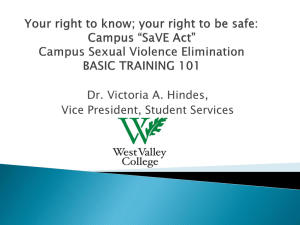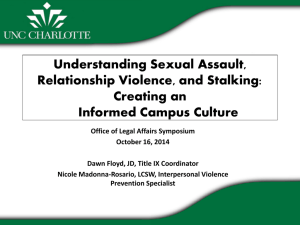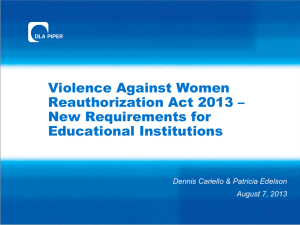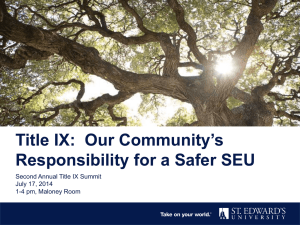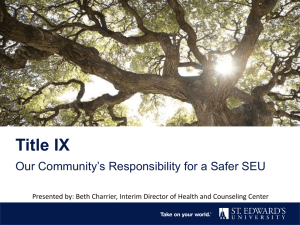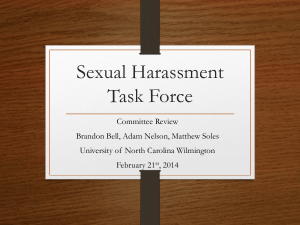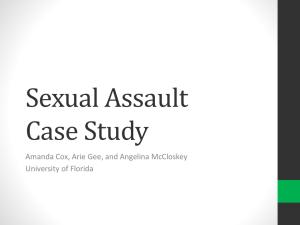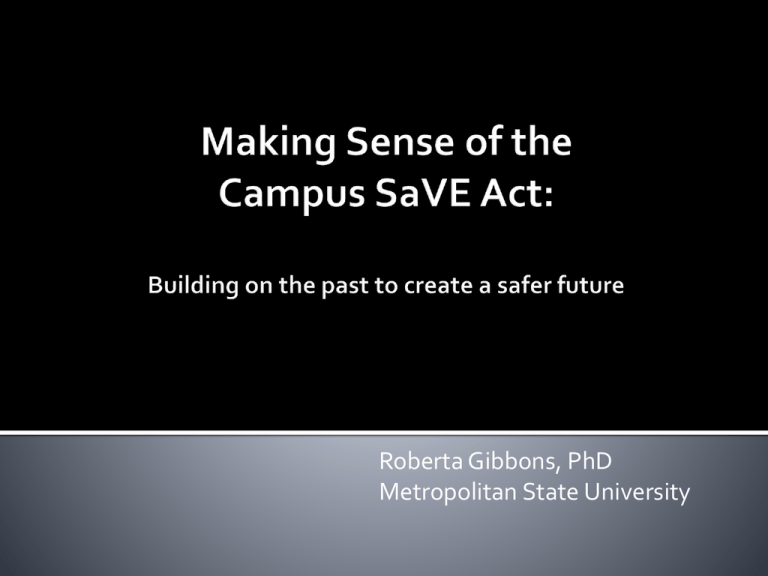
Roberta Gibbons, PhD
Metropolitan State University
Review the pre-SaVE federal requirements for
college campuses related to sexual assault
response
Understand the requirements of the Campus
SaVE Act
Identify changes to the Annual Security Report
Statement of Policy
Identify additional crimes covered
Understand the training requirements
Understand the prevention requirements
Identify the limitations of Campus SaVE
The Clery Act
The Sexual Assault Victim’s Bill of Rights
Title IX and the Dear Colleague Letter
The recently-passed Campus SaVE Act
Must publish annual report (3 years) which
discloses crime statistics
Make timely warnings to the campus community
about crimes that pose an ongoing threat
Must make available a public crime log
Failure to comply can result in significant
monetary fines
Accuser and accused must have the same
opportunity to have others present.
Both parties shall be informed of the outcome of
any disciplinary proceeding.
Survivors shall be informed of their options to
notify law enforcement.
Survivors shall be notified of counseling services.
Survivors shall be notified of options for
changing academic and living situations.
ALL of these are codified under Campus SaVE
Sexual harassment of students, which includes acts of sexual
violence, is a form of sex discrimination prohibited by Title
IX.
Schools must:
o Disseminate a notice of non-discrimination
o Designate at least one employee to be Title IX coordinator
o Publish grievance procedures that provide prompt and
equitable resolution
If a school becomes aware of sexual harassment or
violence, they must take:
immediate and appropriate action to investigate
what occurred;
prompt and effective steps to end the sexual
violence, prevent its recurrence, and address its
effects;
steps to protect the complainant;
Location of complaint does not matter
Complaint can be filed by anyone
Mediation is not appropriate as a primary way to
address incident
“Schools should not wait for completion of criminal
proceeding . . . and, if needed, must take immediate
steps to protect the student”
Must use preponderance of evidence standard *
OCR has given guidance that we should make
every effort to honor victim’s wishes
Establish guidelines regarding confidentiality
that allow for a balance of privacy and ability
to get support
Balance honoring victim’s wishes and
mandatory investigation
Campus SaVE
Re-iterates much of Clery /Victims Bill of Rights
Expands types of crimes Annual Security Report must include
Requires several additions to the ASR statement of policy
Written notice to survivors who make a report
▪ Procedure
▪ Rights
▪ Possible sanctions
Requires annual training for anyone involved in the response
procedure
Requires prevention education for all incoming students and
new employees (bystander and risk reduction)
Categories of Prejudice - actual or perceived:
Race
Gender
Religion
Sexual orientation
National origin*
Gender identity*
Ethnicity
Disability
11
Hate Crimes
Murder and non-
negligent
manslaughter
Forcible sex offenses
Non-forcible sex
offenses
Robbery
Aggravated assault
Burglary
Motor vehicle theft
Arson
Larceny-theft
Simple assault
Intimidation
Destruction/damage/
vandalism of property
Domestic violence*
Dating violence*
Stalking*
12
ASR Policy statements shall include:
“Procedures victims should follow if domestic
violence, dating violence, sexual assault or stalking
occur, including information in writing about—”
▪ The importance of preserving evidence to prove a crime or
obtain a protective order
▪ To whom such incidents should be reported
▪ That, if the victim wishes, campus authorities may assist the
victim in notifying police
▪ Victim’s options to notify (may also decline to notify)
▪ Law enforcement (campus and local)
▪ Campus authorities
13
ASR Policy statements to include
• Written notification of students and employees
about existing
▪
▪
▪
▪
▪
▪
Counseling
Health
Mental health
Victim advocacy
Legal assistance
Other services available for victims
• Both on campus and in the community
14
ASR Policy statements to include:
Rights of victims and institutional responsibilities
regarding
▪
▪
▪
▪
Orders of protection
No contact orders
Restraining orders
Or similar lawful orders
Issued by criminal, civil or tribal court
15
ASR Policy statements to include
Written notification of victims about options for, and
available assistance in, changing (at victim’s request)
▪
▪
▪
▪
Academic
Living
Transportation
Working situations
If reasonably available and
Regardless of whether victim chooses to report to
campus officials or local law enforcement
16
ASR Policy statements to include:
Information about how confidentiality of victims
will be protected, including how publicly available
recordkeeping will be accomplished without
including identifying information about the
victim, to the extent permissible by law.
▪ Timely warnings must withhold the names of victims as
confidential
17
ASR must include “a statement of the
standard of evidence that will be used during
any institutional conduct proceeding arising
from “a report of domestic violence, dating
violence, sexual assault and stalking.”
SaVE does not require a particular standard, but
the DCL advises preponderance of the evidence
(more likely than not)*
18
ASR Policy statements must include:
Possible sanctions or protective measures that [an]
institution may impose following a final
determination of an institutional disciplinary
procedure regarding
▪
▪
▪
▪
▪
▪
Rape
Acquaintance rape
Domestic violence
Dating violence
Sexual assault
Stalking
19
Prompt, fair, impartial investigation
Both parties have the right to have others
present during disciplinary process
Both parties receive written outcomes of
disciplinary proceedings at the same time
A student or employee who reports to an
institution of higher education that s/he has
been a victim of
Domestic violence
Dating violence
Sexual assault
Stalking
whether it has occurred on or off-campus, shall
be provided with a written explanation of his or
her rights and options, as described
21
Institutional disciplinary procedures for such
cases must clearly state that the proceedings
will
“be conducted by officials who receive annual
training on the issues related to”:
▪ The four types of cases: Domestic violence, Dating violence,
Sexual assault, Stalking
▪ How to conduct an investigation “that protects the safety
of victims and promotes accountability”
▪ How to conduct a hearing process “that protects the safety
of victims and promotes accountability”
22
ASR must include a statement of policy
regarding –
Prevention Programs: “to prevent domestic
violence, dating violence, sexual assault, and
stalking”
Ongoing Education Programs “to promote the
awareness of rape, acquaintance rape, domestic
violence, dating violence, sexual assault, and
stalking…”
23
Primary prevention and awareness programs
for all incoming students and new employees
which shall include—
A statement that the institution…prohibits
▪
▪
▪
▪
Domestic violence
Dating violence
Sexual assault
Stalking
Definitions of each of the above “in the
applicable jurisdiction”
24
Primary prevention and awareness programs
for all incoming students and new employees
which shall include—”
the applicable jurisdiction’s “definition of
consent in reference to sexual activity” *
25
Primary prevention and awareness programs for all
incoming students and new employees which shall
include—
“safe and positive options for bystander intervention”
targeted to “prevent harm or intervene” in cases of
domestic violence, dating violence, sexual assault or
stalking
“information on risk reduction to recognize warning
signs of abusive behavior and how to avoid potential
attacks”
26
Institutions must engage in “ongoing
prevention and awareness campaigns for
students and faculty” pertaining to
“Education programs to promote the awareness
of rape, acquaintance rape, domestic violence,
dating violence, sexual assault, and stalking…”
27
Evidence standard was removed from
legislation (Some schools use “clear and
convincing”) ≠Title IX
“report” vs. “actual notice” ≠Title IX
“consent as defined by jurisdiction” vs.
“unwanted” ≠Title IX
Apparent open timeline on “final resolution”
≠Title IX
Appeal possibility lengthens time before OCR
remedy =Title IX
SaVE codifies much of DCL, but not all of it
SaVE re-iterates much Clery/Student Right to
Know/Victims’ rights
SaVE expands hate crimes categories and types
of offenses
SaVE requires prevention programming
SaVE requires annual training for those involved
in campus response/adjudication
SaVE has detailed requirements regarding
campus policy and response to sexual violence
SaVE leaves some questions unanswered

